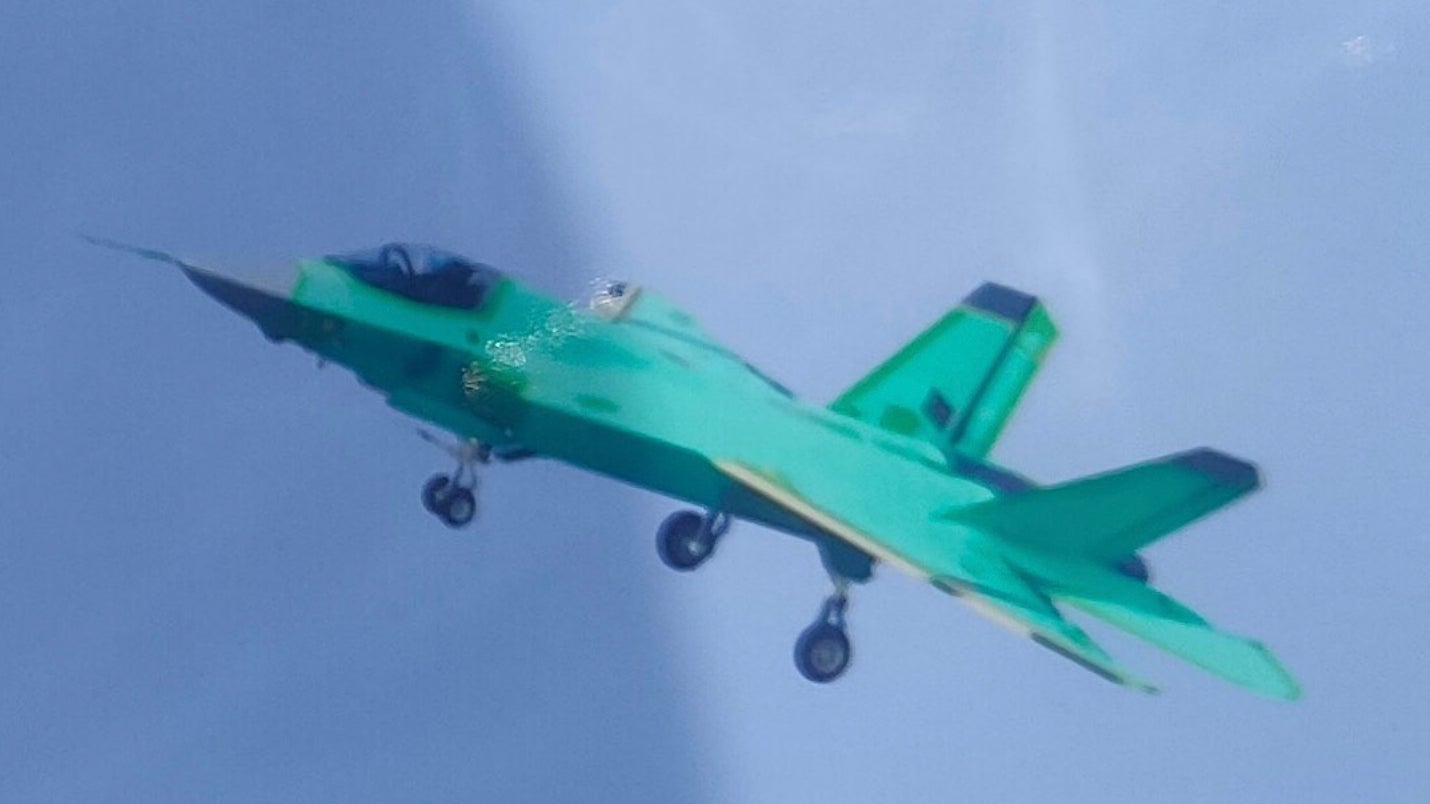Photos beginning to appear on social media apparently show, beyond little doubt, the carrier version of China’s Shenyang FC-31 stealth fighter, which is expected to play a vital role in the continued and impressive development of the People’s Liberation Army Navy (PLAN) carrier force. While we have previously seen an apparent mockup of the jet — the first stealthy carrier-capable fighter to be developed outside the United States — the new images show a prototype flying for what may well be the first time.
The aircraft in question retains the same basic configuration as the land-based FC-31, first flown in prototype form in October 2012, but which has not yet won any orders from the People’s Liberation Army Air Force or export operators, to whom it has been increasingly targeted. Wearing a blue-green primer finish, the new jet has the same twin canted tailfins, twin engines, and high-mounted cockpit of the FC-31, but adds a catapult launch bar and a wing-fold mechanism, confirming it’s intended for carrier operations. Other notable features are a chin-mounted sensor turret, apparently analogous to the F-35’s Electro-Optical Targeting System (EOTS), and what seems to be a remodeled cockpit canopy profile, with a shorter main transparency.
The FC-31 carrier version seems to be derived from the baseline design’s improved second variation, which introduced a number of aerodynamic refinements over the original, including smaller ‘clipped’ and swept vertical tails, a less angular overall appearance, and cleaner surfaces. The second FC-31, which made its first flight in December 2016, is powered by a pair of indigenous WS-13E turbofan engines, replacing the Russian-supplied RD-93 engines used in the first.
The designation of the new carrier fighter remains unknown, but there has been speculation in the past that it could be designated J-21 or J-35.

Being equipped for catapult operations for the outset, the new fighter seems certain to be intended to operate from the forthcoming Type 003 carrier — the third for the PLAN, and the first to have a distinctly domestic design. The Type 003 design is expected to be equipped with an electromagnetic aircraft launch system (EMALS), rather than relying on the ski-jump ramps used on the PLAN’s previous two carriers, the Liaoning and Shandong.

While construction of the Type 003 carrier continues to make rapid progress, a carrier-capable naval version of the FC-31 has long been rumored. This would provide a stealthy complement to the Shenyang J-15, a Chinese-made Sukhoi Flanker derivative that’s in service with the PLAN today, and which goes to sea aboard its first two carriers. A catapult-capable variant of this aircraft has been in testing for some time.

“Development continues on the smaller FC-31/J-31 for export or as a future naval fighter for the PLAN’s next class of aircraft carriers,” according to an annual report on Chinese military developments the Pentagon sent to Congress in 2020.
For its part, China has been tight-lipped about the carrier jet, but in December 2019, a silhouette of the FC-31 appeared on the Weibo microblogging site of the Aviation Industry Corporation of China (AVIC) — of which Shenyang is a subsidiary — described as a “future carrier-borne fighter.” Days later, Shenyang announced it was developing a ‘new’ fighter, leading to speculation this was the long-awaited FC-31 carrier variant, although no such specifics were provided.
Reworking an existing land-based fighter for deck operations is no mean feat. In the past we outlined some of the challenges involved:
Typically, it may involve aerodynamic changes, optimizing the aircraft for the different angles of attack encountered on takeoff and landing, perhaps including additional high-lift devices on the wing. The flight-control system will need adaptation too, and then there are potential structural changes to reinforce the airframe for the stresses of launch and recovery. Invariably, the undercarriage will need to be beefed up and a catapult launch bar and arrester hook are requirements, too. More extensive use of composite materials may be required to prevent corrosion. Finally, for stowage on board ship, the wing panels would require folding mechanisms.
Clearly, the new carrier variant is at a fairly early stage in its development, but its low-observable features and modern characteristics overall would provide the PLAN with a significant new capability to match its power-projection ambitions. However, spinning off the FC-31 into a carrier fighter was likely the plan all along, and its development will benefit greatly from nearly a decade of testing and evolution of its land-based progenitor.
The fighter’s capabilities are expected to be reinforced by the KJ-600 carrier-based airborne early warning aircraft, which has been noted in mock-up form since at least 2018. An actual prototype of this plane was spotted undergoing flight trials last summer and, simultaneous with the appearance of the navalized FC-31, the KJ-600 has again been seen undergoing flight tests, with new photos emerging today as well.
So far, the images of the FC-31 carrier variant seem to be legitimate, but there are likely to be more that will confirm its existence beyond a doubt. With that in mind, we will continue to update this story accordingly. In the meantime, it now seems we have the first evidence that China’s plans for a stealth fighter to equip its future carrier air wings have taken flight.
In a very busy week for Chinese tactical aviation developments, it’s once again clear that Beijing’s airpower ambitions are rapidly taking shape. Now it could very well be that the Type 003 carrier enters into service with a stealth fighter being tested aboard its deck.
Contact the author: thomas@thedrive.com
